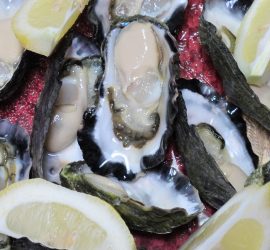With such a long and proud seafaring culture, it’s no surprise that Norwegians really understand fish. Seafood has been an integral part of the culture and economy for centuries. Today, only China exports more seafood than Norway. Those familiar racks of dried fish have been exported since before Viking times as bacalao and stoccafisso/stockfish. The other main seafood items caught here include anglerfish, arctic char, halibut, mussels, haddock, herring, ling, mackerel, plaice, pollack, redfish, saithe, brown crabs, king crabs, crayfish, prawns, lobster, oysters, scallops, langoustine, sea urchin, trout, turbot, salmon, ….and of course cod. Great big tasty cod!
Norway has been a leader in aquaculture. While mussels, oysters and Atlantic salmon are also cultivated extensively in other parts of the world, Norway pioneered the successful farming of rainbow trout in saltwater and Norway continues to invest in innovative fish farming techniques.
Smoked salmon is a characteristically Norwegian staple, eaten for breakfast, lunch, or dinner. Gravlax is also well known globally, and is made by curing salmon for a day or two in salt, sugar, and herbs. Gravlax means “buried salmon” in Norwegian, as once upon a time it was once buried in sand as it was cured, or so the story goes. Many of the traditional fish dishes consist of poached fish with mild tomato based sources and today there is a bigger variation of techniques, ingredients and spices in the mix. Summer feasts are a big deal, with prawns, crabs, fresh white bread and plenty of beer, or øl as it is known here. More exotic dishes made famous by Norway are Lutefisk, often eaten around Christmas, which is made from dried cod or ling soaked in a lye solution for several days making it glutinous. Lutefisk means ‘lye fish’. Rakfisk is another form of cured fish, usually trout that is salted and fermented for several months, then eaten uncooked with flat bread, mustard and dill.
The traditional drink of Norway is aquavit, a spirit made from potatoes and grains, which has a strong flavor and is a Christmas favourite. Noway also produces ciders, mead, and an impressive range of beers.
Cod

Atlantic cod would have to be European history’s most important fish. Found in the North Sea, through Greenland and extending to Newfoundland and Labrador, Vikings learned to dry and preserve it in the cold dry air of Norway of 800AD, and then created a hugely successful export market for it through southern Europe, where it is still popular. The massive stocks discovered off Canada led to the earliest European ventures to the Americas, and cod later became an important fishery for America settlers from the 17th century.
Cod from the cold Arctic sea on their annual spawning run from the Barents sea to the Lofoten islands from January to April are known as ‘skrei’, and are especially highly regarded for their delicate flesh. Cod has a beautiful subtle flavor with very firm flakes, and is flexible for a range of different cooking techniques and recipes. It was most popular in Britain in traditional fish and chips.
Cod liver oil has been popular for centuries as a health tonic with vitamins A, D, and E, and omega 3 fatty acids as well.
Deepwater prawns

Prawns are an important part of summer feasts, and the ceremony of the feast beset starts with the purchase of fresh prawns direct from the trawler at port, and continues well into the long summer evening with big quantities of beer and fresh crusty white bread.
Prawns are caught at night offshore and in Norway’s pristine cold fjords. Norwegian fisheries have studied the lifecycles of prawns in various locations, and know when the best times are to catch them, which assist not only in targeting fisheries but also from an environmental perspective, to minimize the impact on breeding.
The cold, deep waters of Norwegian seas and fjords are very well suited to the feeding and breeding habits of prawns, and sophisticated trawlers are well equipped to manage the catch from the instant prawns are caught until they are sold at the market or direct from the fishing boat at port. Today prawns are used in a wide variety of recipes, as the basis for a range of sophisticated salad dishes, and in creamy traditional Norwegian fiskesuppe (fish soup)
Fjord Trout

A small country like Norway does not become the second largest seafood producer in the world without a lot of innovation, to manage fisheries well, and to open up new aquaculture industries. What Norwegians call ‘fjord trout’ is a huge success story in innovation. Fjord trout are actually rainbow trout which come from America, not Europe, where brown trout come from. Norwegians discovered how to raise young fingerlings in icy glacial freshwater environments and then farm them in fjords where deep, cold seawater regularly circulates and provides perfect conditions for healthy energetic trout to mature and grow very big.
Fjord trout is famed for its deep red colour and rich marbled flesh. Fish are usually harvested at a size of 2.5kg. The strict processes that are enforced for managing harvested fjord trout mean that it is exempted from the usual freezing requirements for fish imports.
The tender and delicate flesh of trout is best suited to recipes that require less vigorous cooking, so baking, light frying or served as smoked trout and in salads and open sandwiches (Smørrebrød in Norwegian).

